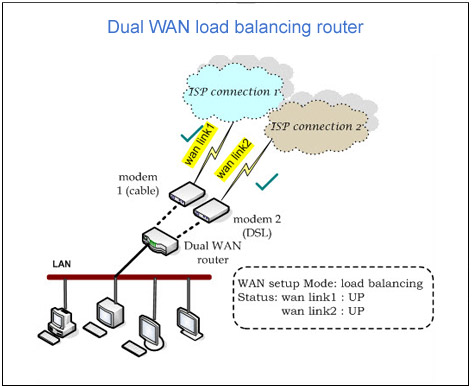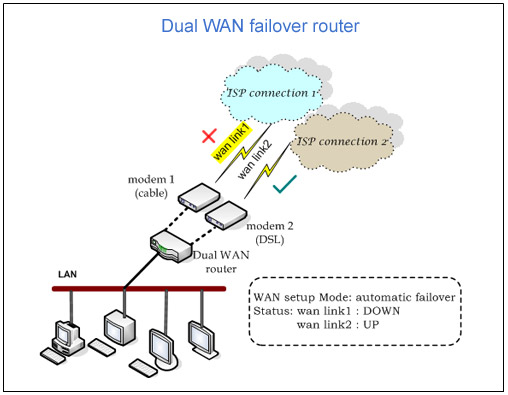With the increasing use of the Internet to service core business functions comes the need for reliable WAN connectivity. A specific aspect of this requirement is for reliable connectivity to particular destinations. A simple and effective method of achieving this is to provide alternative network connections via different Internet Service Providers (ISPs). In this way an outage limited to one network will not result in a loss of connectivity to the essential sites. When a router simultaneously connects to multiple ISPs, the WAN load balancer tries to distribute the router traffic equally across each network interface. You can instead achieve connectivity via multiple WAN interfaces by using routing protocols such as RIP, OSPF or BGP, but such protocols usually choose their routing paths on the basis of metrics instead of dynamic load conditions. A router with two WAN ports connected to different ISPs would route most of its traffic via the port that offered the best metric. This provides alternative connectivity if an ISP fails, but under normal operating conditions, it wastes the alternative port’s bandwidth. WAN load balancing overcomes this limitation.
In general, business organizations configure WAN setup using single Internet connection provided by Internet Service Provider (ISP) connected to their LAN via wan modem. Modem is a device to perform modulation and demodulation of the signals traveling from source to destination. They link the local network to internet via wan port.
Here data transfer takes place when the packet data traverse from source, router routes packet to different nodes in the network using the address label in the routing table to reach the destination. Refer (To see Figure WAN configuration setup) for WAN setup for an organization.

As per (below figure), we can make out the WAN setup with the dual wan router functioning as a load balancer.

In this method, both the wan connections stay ‘active’ and load sharing among them based on their bandwidth. The dual wan load balancing takes 2 broadband connections combining all the bandwidths. We can see wan load balancing by the dual wan connections where one modem will be maintaining high speed (cable modem), and the other can act as a Digital Subscriber Line (DSL).
The internet traffic load balancing handled with both the links (wan link 1 and wan link 2) showing ‘active’ state. Given below is a representation of load balancing mode:
In this mode, only 1 wan link will be ‘active’ and act as ‘primary’. So, when the primary wan connection breaks, the alternative connection will automatically take over the power of the network and go ahead with other operations.

In this mode, both the wan connections will be active and share the load sharing based on their bandwidths. The dual wan load balancing takes 2 broadband connections combining all the bandwidth. We can see wan load balancing through the dual wan connections, where one modem controlling high pace (cable modem) and the second can be Digital Subscriber Line (DSL).
The internet traffic load balancing handled with both the links (wan link 1 and wan link 2) showing ‘active’ state. Given below is a representation of load balancing mode:
In general, network professionals suggest users opt for two connections with various service providers, as it is a reliable choice preferably than using two wan connections of the very provider with varying IP addresses, are endangered since the network can drop its connectivity in case the primary wan connection crashes to perform. So, if you are looking for the most suitable alternative for Dual WAN setup in your network with the highest profits and performance, the go-ahead for the best one!